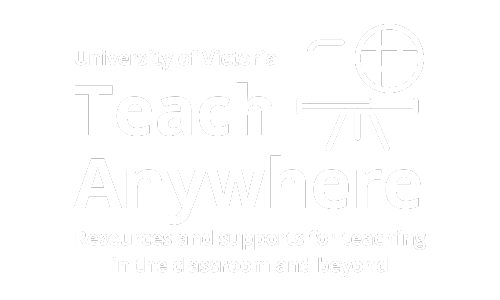In this guide, you will find the information you require to grade undergraduate student writing. This guide will help you grade fairly and efficiently, so that you can support students as they learn how to write.As an instructor, how can you use this guide to help...
Posts by Category:
Grading Toolkit
The following toolkit was developed to assist University of Victoria Chairs and Directors to carry out responsibilities in relation to grading, and to facilitate discussion in their respective units. This Toolkit includes: Literature review about assessment and...
Intended Learning Outcomes
The challenge to designers of curricula in higher education is how to harness the use of learning outcomes to view learning from the perspective of the learner, rather than the lecture, and thereby to enrich the quality of learning experienced by undergraduate...
UVic Institutional-wide learning outcomes
Society requires that people with diverse backgrounds come together and work toward resolving complex environmental, ethical, scientific and social problems. In addition to substantive content knowledge in students’ specific fields of study, all students at the...
Information about grading for Instructors
TerminologyAny mechanism instituted in a course to provide feedback and measure student learning, divided into two sub-categories: formative and summative (see Appendix 2 for a list of both of theseforms).Assessment for learning that is primarily used to inform a...
Information about grading for Chairs and Directors
Many factors contribute to how assessment is approached. Despite evidence that the increase in grades over the years may be due to multiple factors, the real problem lies in grade inequality. Hodges (2014) claims that the use of rubrics with clear criteria eliminates...
Grading and Assessment
Assessment of learning through effective assignment design and effective grading is integral to the teaching process. At UVic all instructors and faculty are required to use the Senate-approved percentage grading scale. For instruction on how grading, please see the...
Learning-centred instructional strategies
What is learning? Student learning is a relatively permanent (not transient) change in students’ knowledge, skills, beliefs, and attitudes Student learning is a process (not a product) inferred from what the student does Student learning arises from what the student...
Teaching online
Learning and instruction in online courses can happen in many different formats or modes. Two major modes are synchronous (real-time, everyone together at the same time) and asynchronous (self-paced or flexible – activities do not necessarily take place at the same...
Assessment points to consider
TerminologyAny mechanism instituted in a course to provide feedback and measure student learning, divided into two sub-categories: formative and summative.Assessment for learning that is primarily used to inform a student (through feedback by verbal, written or other...
We are here to help!
Access your LTSI Faculty Support Team & supports in four ways:
We acknowledge and respect the lək̓ʷəŋən peoples on whose traditional territory the University of Victoria stands, and the Songhees, Esquimalt and W̱SÁNEĆ peoples whose historical relationships with the land continue to this day.
